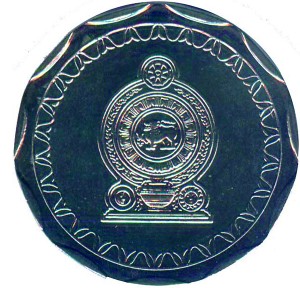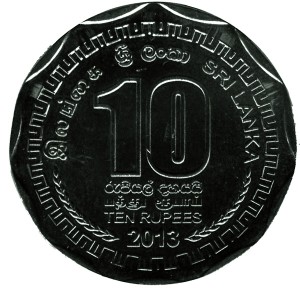New Rs 10 coin slips into circulation
Sri Lanka’s Central Bank (CB) in March gave Mincovna Kremnica of the Slovak Republic the contract, for the supply of 175 Million Rs.10 denomination circulation coins during the period from 2013-2015. To minimize cost of production the order was for pure steel with no nickel plating which helps prevent rusting.
The Nickel Plated Steel Rs 10 circulation coin of this type were first issued in 2010 April and have years 2009 and 2011. It was minted at the Royal Mint in UK and was issued to replace the Rs10 currency note which was last printed with a 2006 date. The first coin consignment from Slovak Mint arrived in Sri Lanka on August 7 and was put into circulation without any notification to the public the next week. It was first noticed in circulation by a keen collector on August 23 and reported to me. I went to the HQ of the Bank of Ceylon and was informed they had no Rs.10 coins. I then made a request at the cash counter of CB. They kindly obliged and gave me a nice small cellophane pack of 100 Rs10 coins. In contrast, the Royal Mint packed in large plastic bags of 1000 coins.
 |
 |
When I phoned the CB Museum in Rajagiriya the next day, I was assured that no such coin has been issued as yet. The CB currency department had not even informed the staff in its own currency museum.
The new Rs10 coin was expected to have identical design to the old. However this Slovak mint coin has clearly visible differences with the Royal Mint issue. The Armorial ensign is 7.5 per cent smaller and the large numeral 10 is 6 per cent smaller. Many of the other design features are correspondingly slightly smaller. The flat edges on the rim are smaller and the cantilever loops around the 11 sided coins are not joined. The high-raise is also less. It will most probably feel different to a blind person.
Previously the CB minted 25 cent and 50 cent coins with year 2009. Nearly two years after it was issued in 2011, no coin collector I know had found a 2009 25 cent coin from circulation. Despite many requests to the CB for a mint bag of these 2009 coins, I was unable to get any. Specific requests via my bank were declined by the CB. Finally they said there were none left of that year in the CB Vault. An easy reply when they can’t easily locate any. We were almost convinced they did not exist, despite what we understood from the CB. Although unlikely, maybe the Royal Mint sent coins with 2006 year for the 2009 25 cent order.
In 2013 February, I went and picked up circulated new type 25 cent and 50 cent coins from the famous Kelaniya Raja Maha Vihara. I was told that it was from about 2 to 3 months collection, since these low denominations are now a very tiny fraction of the coins put in tills.
Ultimately after many hours looking at the year on over 1400, 25 cent and 1700, 50 cent coins, I found just four 2009 25 cent and thirty five 2009 50 cent coins. There were 13 foreign coins among the 25 cents included 5 Euro cents, 4 Singapore cents, 3 Thai 25 Satang and 1 UAE 5 Fils. The 2 Foreign coins among the 50 cents were a 50 ore from Norway and a 1 Sen from Malaysia.
Far more foreign coins than 2009, 25 cent coins in the same lot is very surprising. I agree foreign coins are probably over represented in temple tills of a Vihara frequented by foreign tourists, but I assume these were just few that missed detection, when the coins were sorted.
Getting into circulation requires the CB to get a now rare request for these coins from a bank. The coins being issued from the bank to a merchant, and a customer being given the coin in change, and then using it. Merchants no longer use or give cents coins and even if someone gets one, will it get reused or thrown. It is now of no value to even give a beggar or put in a collection till. The 25 cent will now get thrown more often and may explain the under representation of 2009 year coins in any circulated lot.
The currency Department of the CB mostly announces NCLT (Non Circulating Legal Tender) coins. So while these high value commemoratives now costing over Rs. 7500 each, have become too expensive for most collectors, the low value regular coins that don’t effectively circulate are almost impossible to find.
In a recent interview the superintendent of currency said it costs the CB Rs. 3 to mint a Rs1 coin. Maybe they wish to discourage the hobby of coin collecting, since it now costs the CB more than the face value to mint them.
(The writer maintains an educational website on Lankan coins at http://coins.lakdiva.org and is the President of the Sri Lanka Numismatic Society)
comments powered by Disqus

